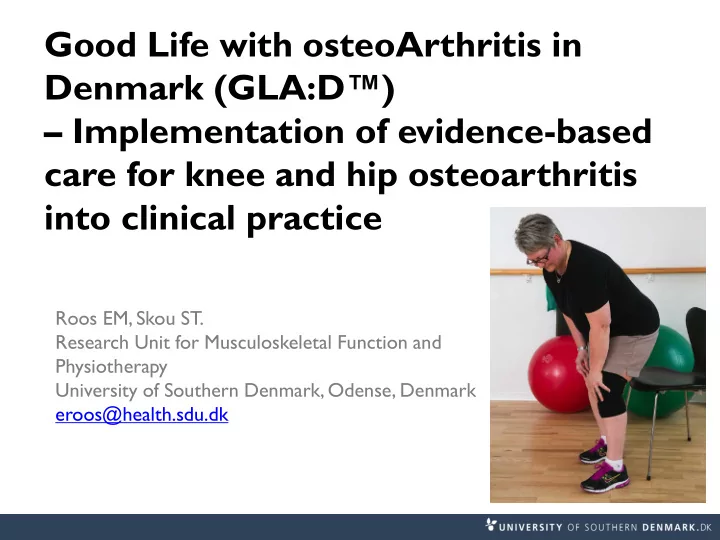

Good Life with osteoArthritis in Denmark (GLA:D™) – Implementation of evidence-based care for knee and hip osteoarthritis into clinical practice Roos EM, Skou ST. Research Unit for Musculoskeletal Function and Physiotherapy University of Southern Denmark, Odense, Denmark eroos@health.sdu.dk
Purpose To implement treatment guidelines for knee and hip osteoarthritis (OA) and evaluate the results at 3 and 12 months
Methods ™
1. A two-day course for physiotherapists (first course held in January 2013)
2. Standardized treatment Three 1.5-hour sessions of patient education 12 sessions of individualized, physiotherapist supervised neuromuscular exercise for patients in groups Additional treatments are allowed (weight control, PT, etc.)
3. Evaluation Evaluation by patient and physical therapist are entered into the GLA:D-registry: Baseline 3 months 12 months Patient descriptives Self-reported outcomes Objective tests
Results Currently GLA:D is offered at 290 clinics nationwide
Results The registry holds data from more than 8 600 patients baseline 3 month 12 month 2013 2014 2015
Results The average GLA:D patient is an overweight 64 year old married woman with knee pain. Most patients have problems from more than one joint and medical comorbidities are common
Results from the GLA:D registry Dec 31, 2014 Data from 137 GLA:D clinics from all over Denmark 3.637 patients (75 % women, mean age 63.9 år, 74 % knee OA) had started the program 2.290 patients had completed the 3 mo follow-up 425 patients had completed the 12 mo follow-up
Results from the GLA:D registry Dec 31, 2014 Data from 137 GLA:D clinics from all over Denmark 3.637 patients (75 % women, mean age 63.9 år, 74 % knee OA) have started the program 2.290 patients have completed the 3 mo follow-up 425 patients have completed the 12 mo follow-up
GLA:D Results 2014 Sick leave Prior to GLA:D, 13 % were on sick leave during the last year due to their hip/knee During the year following GLA:D, only 8% had been on sick leave due to their hip/knee
GLA:D Results 2014 Sick leave Prior to GLA:D, 13 % were on sick leave during the last year due to their hip/knee During the year following GLA:D, only 8% had been on sick leave due to their hip/knee Use of pharmacological pain relief Prior to GLA:D 57 % used paracetamol, NSAIDs or opioids due to their hip/knee After the GLA:D intervention (3 mo follow-up) only 36% used pharmacological pain relief due to their hip/knee
GLA:D Results 2014 Physical Activity level 33% had improved their Physical Activitly level at 3 mo, and 30% had improved their physical activity level at 12 mo compared to prior to GLA:D
GLA:D Results 2014 Physical Activity level 33% had improved their Physical Activitly level at 3 mo, and 30% had improved their physical activity level at 12 mo compared to prior to GLA:D Pain intensity Prior to GLA:D it was 48 (VAS 0-100) for hip OA and 47 for knee OA Reduction with 23% and 30% for hip OA at 3 and 12 mo Reduction with 31% and 36% for knee OA at 3 and 12 mo 94 % of patients like GLA:D ”much” or ”very much” and use what they have learned at least weekly
Discussion
Implementation lags behind Early treatment for osteoarthritis works! Research evidence and Clinical results Politics Organization Financing Patient beliefs
Barriers to change in health care Professional hierarchies Financial incentives Health care organisation Patient beliefs: I need an x-ray I need MR I need surgery
Barrier for implementation of education and exercise: Not sexy, low tech, cheap with no industry involvment 300 USD
Funding 20.000 USD in total from PT funds and Rheumatism Association in Denmark Used to establish the electronic database/registry Enthusiasm, hard work & frustration Supportive university providing the setting for the courses and allowing me to spend time on this project Physiotherapists pay 450 USD out of pocket to take the certification course Patients pay 300 USD out of pocket for education & exercise PTs are reimbursed with 200 USD from health care/insurers
Conclusion The GLA:D concept is feasible in clinical practice Data from the first two years of enrollment demonstrate reduced pain and increased quality of life with improvements persisting 9 months after the intervention ends Teaching content of clinical guidelines to physiotherapists and providing a free of charge registry for data collection increase the quality of care provided for patients with knee and hip OA Certification Education Exercise Evaluation + + +
™ Thank you!
Contact persons in Canada: Rhona McGlasson, Executive director Bone and Joint Canada rhona.mcglasson@bell.net Aileen Davis, Professor University of Toronto adavis@uhnresearch.ca
Recommend
More recommend